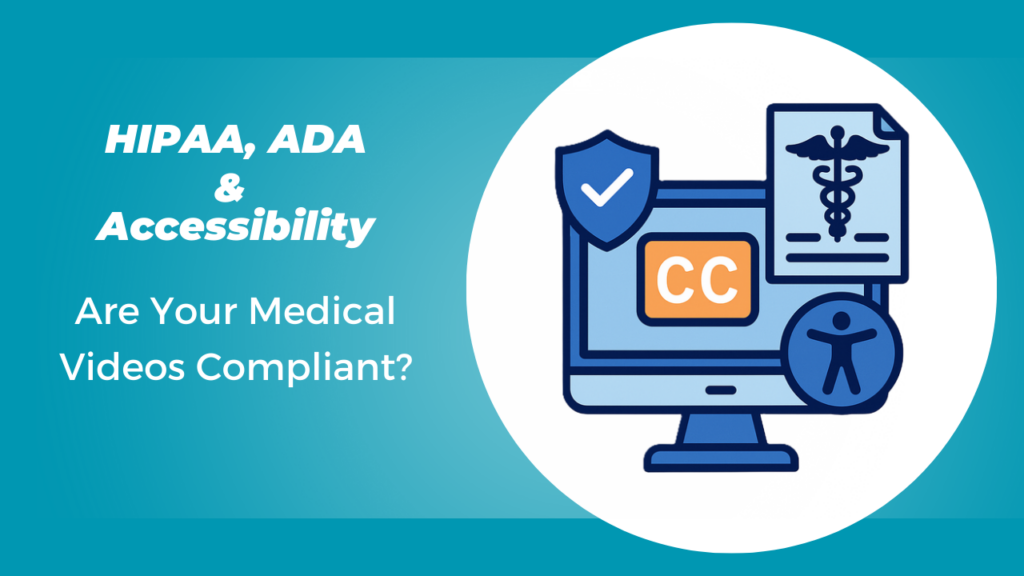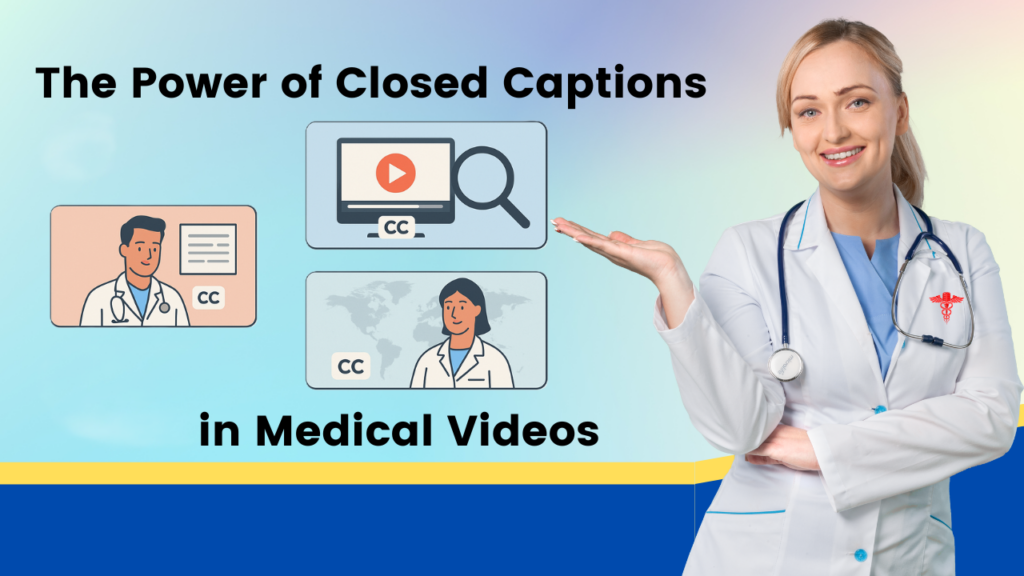HIPAA, ADA, and Accessibility: Are Your Medical Videos Compliant?

As healthcare increasingly embraces digital tools, video has become a cornerstone of modern communication—used for patient education, telemedicine, staff training, and public health awareness. But with this shift comes responsibility: ensuring that your medical videos are not only informative but also accessible and legally compliant. If your organization shares videos that lack closed captions or accessibility features, you could be at risk of violating key U.S. laws such as the Americans with Disabilities Act (ADA), Section 504/508 of the Rehabilitation Act, and indirectly, HIPAA. Here’s what you need to know—and how to ensure your video content meets both ethical and legal standards. What Laws Apply to Medical Video Accessibility? 1. Americans with Disabilities Act (ADA) The ADA requires that communications—including digital content—be accessible to individuals with disabilities. Under Title II (public institutions) and Title III (private entities that serve the public, such as hospitals and clinics), closed captions are considered an “auxiliary aid” required to ensure effective communication. 2. Section 504 and Section 508 Section 504 prohibits discrimination on the basis of disability in programs receiving federal funding, which includes many healthcare institutions. Section 508 specifically requires that all electronic communications and information technology (including videos) be accessible. 3. HIPAA and Digital Accessibility While HIPAA doesn’t explicitly mention captions or video accessibility, it does require that protected health information (PHI) be shared in a secure, patient-accessible format. If a patient who is deaf or hard of hearing cannot understand an educational or diagnostic video due to missing captions, your organization may face challenges in proving effective and secure communication. What Are the Risks of Non-Compliance? Failing to caption your videos can result in: Legal liability for ADA and Section 504/508 violations OCR investigations and potential lawsuits Loss of federal funding for non-compliant institutions Reputational damage, especially in public-facing communications Several high-profile lawsuits—including against universities, hospitals, and government agencies—have emphasized that video accessibility is not optional. What Makes a Video Compliant? To ensure compliance, your medical videos should include: Closed captions for spoken content Descriptions of important non-speech audio (e.g., alarms, instructions) Keyboard and screen reader navigation (for embedded players) Accurate medical terminology that is free from transcription errors Videos must also be delivered in a format that is equally effective and timely for viewers with disabilities, matching the experience of other viewers. How Closed Captions Ensure Compliance Lorem ipsum dolor sit amet, consectetur adipiscing elit. Ut elit tellus, luctus nec ullamcorper mattis, pulvinar dapibus leo. Closed captions do more than provide text for spoken words. They: Ensure equal access for people with hearing loss Satisfy ADA and Section 508 auxiliary aid requirements Support multilingual auto-translation Improve comprehension and engagement across all audiences Enable training, diagnosis, and informed consent without exclusion For example, a video explaining how to administer insulin must be fully understandable by every patient—regardless of hearing ability—or your institution could be liable for unequal treatment. Why MedXcribe? MedXcribe is an AI-powered captioning tool designed specifically for the medical industry. It provides: Clinically accurate transcripts with correct medical terms Support for HIPAA-compliant environments Offline and secure workflows Fast turnaround for lectures, consultations, and training videos Captions that meet ADA, 504, and 508 standards Whether you’re a hospital, private clinic, university, or health tech company, MedXcribe helps you avoid legal pitfalls while improving access for every viewer. Medical video accessibility is not a trend—it’s a legal and ethical necessity. By implementing closed captions and ensuring digital compliance, your organization shows a commitment to inclusion, reduces risk, and improves communication with all patients. Make compliance your competitive advantage. Let MedXcribe help you caption smarter, faster, and fully compliant.
The Power of Closed Captions in Medical Videos

In the evolving world of digital health education, video content is now a staple for sharing knowledge. From lectures and consultations to surgical demonstrations, medical YouTubers and educators are turning to visual media to reach wider audiences. But there’s one tool that significantly enhances the effectiveness and accessibility of these videos: closed captions. Closed captions aren’t just a feature for convenience—they are a game changer in medical communication. Here’s why they matter: Increase Discoverability Through SEO Strategically using key medical terms in your closed captions plays a vital role in making your content more discoverable on platforms like YouTube. When you include accurate phrases such as “eGFR levels,” “stage 3 kidney failure,” or “dietary restrictions,” these terms become part of your video’s searchable metadata. This significantly improves your content’s ranking in search results and increases the chances of being featured in recommended or related video sections. As a result, your content can organically reach a larger and more relevant audience—without the need for paid promotion—making closed captioning both an accessibility tool and a powerful SEO tactic. Medical videos that incorporate such terminology are far more likely to connect with viewers actively seeking trusted information on specific conditions. These keywords are commonly used by patients, caregivers, and professionals searching for content that’s medically reliable and educational. When you align your script and captions with these phrases, you help your video meet the needs of those who are intentionally seeking clarity, support, or solutions. Expand Global Reach Medical education content has global value, but language differences often restrict access. Viewers in non-English-speaking regions may find it challenging to understand complex medical terms if they rely solely on audio. Captions help overcome this barrier by providing textual support for those who aren’t fluent in the video’s spoken language, enhancing both comprehension and confidence. With accurate English captions in place, auto-translation features on platforms like YouTube can localize your content into languages like Hindi, Spanish, French, and more. This opens doors for international students, healthcare workers, and patients to engage with your video. It also fosters equity in healthcare education, ensuring that life-saving medical knowledge can cross borders and reach communities around the world. Support Viewers with Hearing Impairments Closed captions are essential for making content inclusive to the deaf and hard-of-hearing community. In medical contexts, missing out on verbal instructions or safety cues could lead to misinformation or dangerous misunderstandings. For patients relying on video content to manage chronic illnesses or for students preparing for clinical exams, accessibility isn’t just a convenience—it’s a necessity. High-quality captions help mitigate that risk by converting audio into accurate, readable text. They can also include non-speech audio cues—like [heartbeat sound] or [machine beeping]—ensuring that the full scope of audio information is accessible to everyone. By meeting accessibility standards, you’re not just checking a compliance box; you’re empowering a broader audience to learn and act confidently. Improve Viewer Retention and Comprehension Medical videos often involve dense terminology and fast-paced explanations. This can be overwhelming for learners, especially those reviewing complex subjects like pharmacology, anatomy, or cardiology. Viewers may pause, rewind, or even abandon a video if they can’t follow what’s being said. Captions act as a crucial learning aid that reinforces auditory information visually. Captions serve as a helpful reinforcement tool, allowing viewers to read along, pause, and re-read sections. This extra layer of clarity improves understanding and increases retention. They also aid non-native English speakers, auditory learners, and even viewers in noisy environments. The result is better comprehension, higher engagement, and more meaningful learning outcomes across the board. Strengthen Professionalism and Accuracy Clarity and precision are vital in medical communication, and your video captions should reflect that standard. Misspelled terms or incorrect phrasing can reduce your credibility, especially when targeting an educated or clinical audience. Inaccurate or inconsistent subtitles can create confusion or give an impression of carelessness, which undermines the seriousness of the subject matter. Accurate captions enhance the professionalism of your content. Correctly transcribed terms—like “Clopidogrel” or “Atorvastatin”—reinforce your authority as a medical expert and ensure that viewers trust your material. Additionally, polished captions demonstrate respect for your viewers’ intelligence and time, strengthening your content’s value within academic, research, and clinical circles. How MedXcribe Helps If you’re a medical content creator looking for fast, high-quality captions tailored for clinical accuracy, MedXcribe is the tool for you. Using AI and expert refinement, MedXcribe generates captions ideal for lectures, patient education, surgical recordings, and more—with support for offline workflows and strong data privacy. The power of closed captions lies in their ability to bridge gaps—between speaker and viewer, language and understanding, sound and silence. For medical videos, they aren’t just helpful—they’re essential. Start captioning your content today to boost your impact, reach, and credibility.
